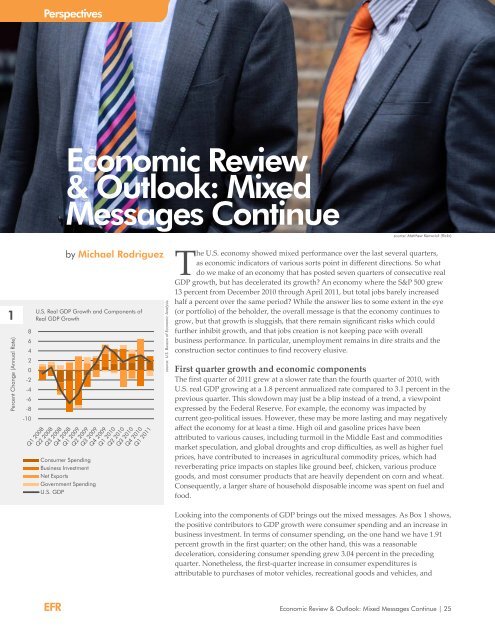June 2011 - Parsons Brinckerhoff
June 2011 - Parsons Brinckerhoff
June 2011 - Parsons Brinckerhoff
Create successful ePaper yourself
Turn your PDF publications into a flip-book with our unique Google optimized e-Paper software.
Perspectives<br />
Economic Review<br />
& Outlook: Mixed<br />
Messages Continue<br />
source: Matthew Kenwrick (flickr)<br />
1<br />
Percent Change (Annual Rate)<br />
8<br />
6<br />
4<br />
2<br />
0<br />
-2<br />
-4<br />
-6<br />
-8<br />
-10<br />
by Michael Rodriguez<br />
U.S. Real GDP Growth and Components of<br />
Real GDP Growth<br />
Consumer Spending<br />
Business Investment<br />
Net Exports<br />
Government Spending<br />
U.S. GDP<br />
source: U.S. Bureau of Economic Analysis<br />
The U.S. economy showed mixed performance over the last several quarters,<br />
as economic indicators of various sorts point in different directions. So what<br />
do we make of an economy that has posted seven quarters of consecutive real<br />
GDP growth, but has decelerated its growth? An economy where the S&P 500 grew<br />
13 percent from December 2010 through April <strong>2011</strong>, but total jobs barely increased<br />
half a percent over the same period? While the answer lies to some extent in the eye<br />
(or portfolio) of the beholder, the overall message is that the economy continues to<br />
grow, but that growth is sluggish, that there remain significant risks which could<br />
further inhibit growth, and that jobs creation is not keeping pace with overall<br />
business performance. In particular, unemployment remains in dire straits and the<br />
construction sector continues to find recovery elusive.<br />
First quarter growth and economic components<br />
The first quarter of <strong>2011</strong> grew at a slower rate than the fourth quarter of 2010, with<br />
U.S. real GDP growing at a 1.8 percent annualized rate compared to 3.1 percent in the<br />
previous quarter. This slowdown may just be a blip instead of a trend, a viewpoint<br />
expressed by the Federal Reserve. For example, the economy was impacted by<br />
current geo-political issues. However, these may be more lasting and may negatively<br />
affect the economy for at least a time. High oil and gasoline prices have been<br />
attributed to various causes, including turmoil in the Middle East and commodities<br />
market speculation, and global droughts and crop difficulties, as well as higher fuel<br />
prices, have contributed to increases in agricultural commodity prices, which had<br />
reverberating price impacts on staples like ground beef, chicken, various produce<br />
goods, and most consumer products that are heavily dependent on corn and wheat.<br />
Consequently, a larger share of household disposable income was spent on fuel and<br />
food.<br />
Looking into the components of GDP brings out the mixed messages. As Box 1 shows,<br />
the positive contributors to GDP growth were consumer spending and an increase in<br />
business investment. In terms of consumer spending, on the one hand we have 1.91<br />
percent growth in the first quarter; on the other hand, this was a reasonable<br />
deceleration, considering consumer spending grew 3.04 percent in the preceding<br />
quarter. Nonetheless, the first-quarter increase in consumer expenditures is<br />
attributable to purchases of motor vehicles, recreational goods and vehicles, and<br />
EFR Economic Review & Outlook: Mixed Messages Continue | 25
















